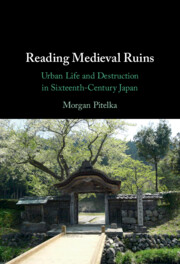Book contents
- Reading Medieval Ruins
- Reading Medieval Ruins
- Copyright page
- Contents
- Figures
- Maps
- Tables
- Acknowledgments
- Note on the Text
- Prologue
- 1 A Provincial Palace City as an Urban Space
- 2 The Material Culture of Urban Life
- 3 Late Medieval Warlords and the Agglomeration of Power
- 4 The Material Foundations of Faith
- 5 Culture and Sociability in the Provinces
- 6 Urban Destruction in Late Medieval Japan
- Epilogue
- Bibliography
- Index
3 - Late Medieval Warlords and the Agglomeration of Power
Published online by Cambridge University Press: 31 March 2022
- Reading Medieval Ruins
- Reading Medieval Ruins
- Copyright page
- Contents
- Figures
- Maps
- Tables
- Acknowledgments
- Note on the Text
- Prologue
- 1 A Provincial Palace City as an Urban Space
- 2 The Material Culture of Urban Life
- 3 Late Medieval Warlords and the Agglomeration of Power
- 4 The Material Foundations of Faith
- 5 Culture and Sociability in the Provinces
- 6 Urban Destruction in Late Medieval Japan
- Epilogue
- Bibliography
- Index
Summary
This chapter traces the rise of the Asakura clan from mid-ranking warriors to warlords of the province of Echizen, and the emergence of Ichijōdani as the thriving capital of the region for a century. It considers the construction of a palatial residence near a fortified castle, and the resulting growth of a city around this pairing, as one of many forms of elite warrior politics in late medieval Japan
- Type
- Chapter
- Information
- Reading Medieval RuinsUrban Life and Destruction in Sixteenth-Century Japan, pp. 93 - 119Publisher: Cambridge University PressPrint publication year: 2022

